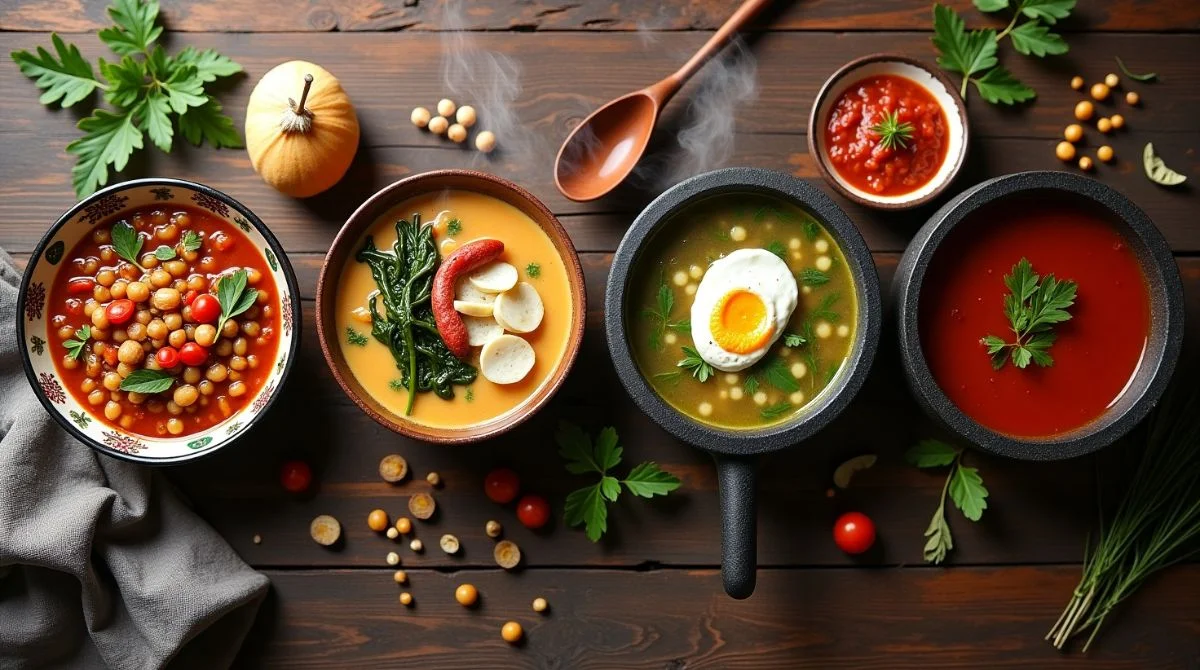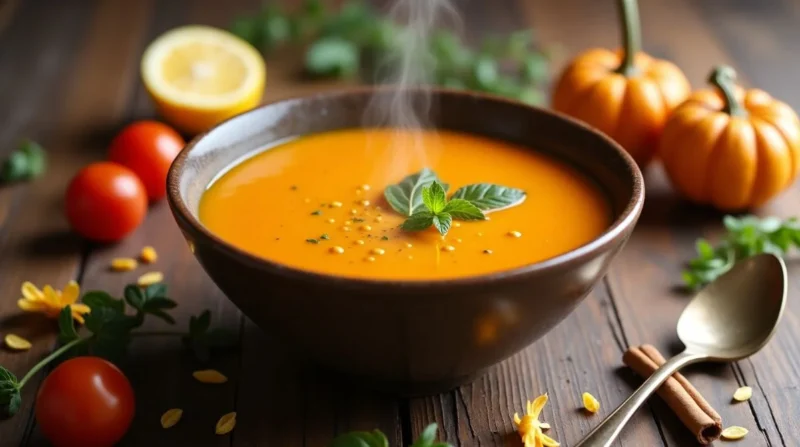Table of Contents
Soup brings comfort and warmth, and adapts beautifully to the changing seasons. Whether it’s a light, refreshing bowl in the spring or a hearty, warming pot in the winter, soups can showcase the best of seasonal produce and flavors. Let’s explore a variety of soup recipes that you can enjoy throughout the year, each tailored to the unique offerings of each season.
Spring: Embracing Freshness
As the chill of winter fades, spring brings a bounty of fresh vegetables and herbs. Soups during this season are lighter, focusing on the vibrant flavors of new produce.
- Asparagus and Leek Soup: A delicate blend of tender asparagus and mild leeks, this soup captures the essence of spring. A touch of cream adds richness without overpowering the fresh flavors.
- Pea and Mint Soup: Sweet peas paired with fresh mint create a refreshing and light soup, perfect for a spring lunch.
- Watercress and Potato Soup: Peppery watercress combined with creamy potatoes offers a balanced and nourishing bowl.
These soups not only celebrate the season’s produce but also provide a gentle transition from the hearty dishes of winter.
Summer: Cooling and Refreshing
Summer’s heat calls for soups that are cool, light, and refreshing. Cold soups become the stars, offering relief from the warmth while still delivering on flavor.
- Gazpacho: A classic Spanish cold soup made from ripe tomatoes, cucumbers, bell peppers, and onions, blended with olive oil and vinegar. It’s a zesty and hydrating dish perfect for hot days.
- Salmorejo: Originating from Andalusia, this thicker cousin of gazpacho combines tomatoes, bread, garlic, and olive oil, topped with hard-boiled eggs and jamón.
- Cucumber and Yogurt Soup: A cooling blend of cucumbers, yogurt, and dill, this soup is both refreshing and satisfying.
These chilled soups are not only easy to prepare but also make excellent starters or light meals during the summer months.
Autumn: Hearty and Nourishing
As leaves turn and temperatures drop, autumn brings a desire for heartier, warming soups that utilize the season’s rich harvest.
- Butternut Squash Soup: Roasted butternut squash blended with onions, garlic, and a hint of nutmeg creates a creamy and comforting soup.
- Minestrone: An Italian classic filled with seasonal vegetables, beans, and pasta, making it a wholesome meal in a bowl.
- Pumpkin and Apple Soup: Combining the sweetness of pumpkin and tartness of apples, this soup is a delightful balance of flavors.
Invastor
These soups not only warm the body but also celebrate the abundance of autumn produce.
Winter: Rich and Comforting
Winter’s cold demands soups that are rich, hearty, and deeply satisfying. These soups often feature robust flavors and ingredients that provide warmth and comfort.
- French Onion Soup: Caramelized onions simmered in beef broth, topped with toasted bread and melted cheese, create a deeply flavorful experience.
- Chicken and Sweetcorn Soup: A comforting blend of tender chicken and sweet corn in a savory broth, perfect for cold nights.
- Lentil and Sausage Soup: Hearty lentils combined with flavorful sausage make for a filling and warming dish.
These soups are ideal for cozy evenings, offering both nourishment and comfort during the coldest months.
Global Soups to Enjoy Year-Round
Beyond seasonal variations, many global soups offer flavors and ingredients that can be enjoyed any time of the year.

- Harira (Morocco): A traditional Moroccan soup made with tomatoes, lentils, chickpeas, and spices, often enjoyed during Ramadan but delightful year-round.
- Caldo Verde (Portugal): A simple yet flavorful soup featuring potatoes, collard greens, and chorizo, offering comfort in every spoonful.
- Tteokguk (Korea): A rice cake soup traditionally eaten during the Korean New Year, symbolizing good luck and the gaining of a year in age.
- Borscht (Ukraine): A beet-based soup that can be served hot or cold, offering a sweet and tangy flavor profile.
These international soups provide a culinary journey, introducing diverse flavors and traditions to your table.
Budget-Friendly and Zero Waste Cooking
1. Make Use of Scraps
Don’t throw away veggie peels, herb stems, or leftover bones. Simmer them in water to make a flavorful broth. Homemade broth is much cheaper and healthier than store-bought versions, and it helps you get the most out of your groceries.
2. Transform Leftovers
Leftovers that might otherwise go uneaten can be turned into soup. That extra roast chicken, cooked rice, or half-used vegetables can become part of a new and delicious dish. This makes your meals more exciting and prevents food from going to waste.
3. Use Inexpensive Ingredients
Soups made with simple ingredients like carrots, potatoes, lentils, and beans are very affordable but still filling. You can make large batches for just a few dollars, feeding the whole family or freezing portions for future meals.
4. Cook Once, Eat Many Times
One big pot of soup can make several meals. It stores well in the fridge and freezes perfectly. This makes soup a great option for busy people or families who want something quick, healthy, and homemade without cooking every night.
Tips for Soup Preparation and Enjoyment
- Use Seasonal Ingredients: Selecting produce that’s in season ensures better flavor and nutritional value.
- Batch Cooking: Prepare large quantities and freeze portions for convenient meals later.
- Garnish Thoughtfully: Toppings like fresh herbs, a drizzle of cream, or crunchy croutons can enhance both flavor and presentation.
- Pair with Sides: Complement your soup with appropriate sides, such as crusty bread, salads, or sandwiches, to create a complete meal.
Health Benefits of Eating Soup
1. Hydration Boost
Soup has a high water content, especially broth-based varieties, which helps keep your body hydrated. This is especially helpful during colder seasons when people often forget to drink enough water. A warm bowl of soup can maintain your fluid intake while satisfying your hunger.
2. Low in Calories, High in Nutrition
Soups made with lots of vegetables, lean meats, or legumes are typically low in calories but high in essential nutrients. They provide a satisfying meal without overloading your diet with fats or sugars, making them perfect for anyone aiming for healthier eating.
3. Supports Good Digestion
Warm liquids are gentle on the stomach. Soups that include digestion-friendly ingredients like ginger, garlic, and leafy greens help soothe the digestive system and promote healthy gut function. Blended soups are especially good for those with sensitive digestion.
4. Immune System Support
Certain soup ingredients have natural immune-boosting properties. Chicken soup, for instance, contains amino acids that reduce inflammation, while garlic and onions are rich in antioxidants. These help your body fight off colds and other infections, especially in winter.
5. Helps With Weight Management
Starting your meal with soup can help you eat less overall. It makes you feel full faster because of its water content and volume. Choosing low-calorie soups before your main course is a smart strategy for anyone trying to lose or maintain weight.
Tips for Making the Perfect Soup
1. Start with a Flavorful Base
- A tasty soup starts with a good foundation.
- Sauté onions, garlic, or herbs in a little oil before adding broth.
- Use homemade or store-bought broth for extra depth of flavor.
- This first step brings out the aroma and gives your soup a rich taste.
2. Layer Your Ingredients
- Add the harder, longer-cooking items like carrots or potatoes first.
- Softer vegetables like peas, greens, or corn can go in later.
- This makes sure everything is cooked just right, not too soft or raw.
- Staggering ingredients also keep the texture fresh and balanced.
3. Don’t Overdo the Seasoning
- Add a small amount of salt and pepper at the beginning.
- Taste the soup as it cooks, then adjust seasonings if needed.
- Let the flavors come together slowly, it gets better with time.
- Add fresh herbs or a squeeze of lemon at the end for brightness.
4. Use What You Have
- Soups are forgiving; no need to follow a strict recipe.
- Use up leftover veggies, meats, grains, or beans.
- Swap ingredients for what’s in your fridge or pantry.
- It’s a smart way to save money and reduce kitchen waste.
5. Blend for Creaminess Without Cream
- Use a blender or hand mixer to blend part of the soup.
- This makes it thick and creamy without needing dairy.
- Great for potato, cauliflower, lentil, or tomato soups.
- You can blend half the soup and leave the rest chunky for texture.
6. Store and Reheat Wisely
Let the soup cool before putting it in the fridge or freezer.
- Use airtight containers to keep it fresh longer.
- Most soups last 4–5 days in the fridge or up to 3 months frozen.
- Reheat slowly on the stove to keep the flavor and texture perfect.
Conclusion
Soup is one of the easiest, healthiest, and most comforting meals you can make at home. Whether you’re using fresh seasonal ingredients, turning leftovers into something new, or making a big batch to freeze for later, soup always delivers flavor and comfort in every bowl. From hearty winter stews to light summer blends, there’s a perfect soup for every season and every mood. It’s a budget-friendly, flexible, and nourishing choice for anyone who loves home-cooked meals made with love and care.









